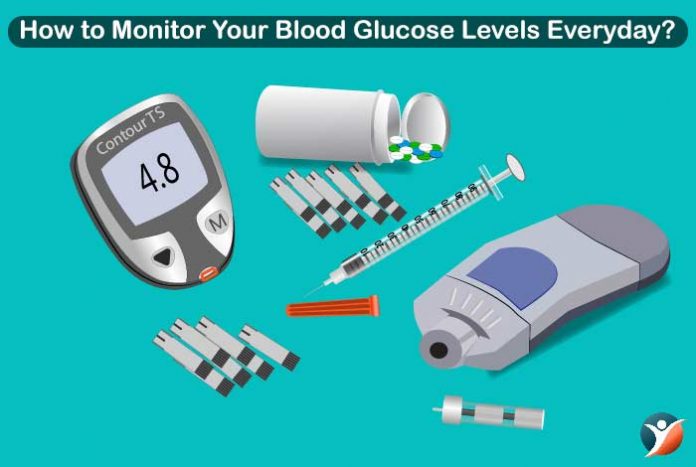
Recently diagnosed with diabetes and feeling like your world has crashed? Yes, we can feel your pain. But hold on, is diabetes so irritating and discouraging? The answer is a big no. If you are doing it right, it is easy to live with diabetes and that too almost normally. Let’s get deeper into the world of diabetes. Well, exactly it is not great being a diabetic but knowing how to check and efficiently monitor your blood glucose levels can actually make this task a little less arduous. And, don’t worry it doesn’t pain as bad as you think it would. Read-on to know everything about the blood glucose monitoring and how to check it every single day.
Table of Contents:
- Self-Monitoring Your Blood Glucose Levels
- How Can Self-Monitoring Blood Glucose Levels Help You?
- Who Must Check Their Blood Glucose Levels?
- When and How to Check Blood Glucose Levels?
- How to Select Best Glucose Meter?
- What Are Recommended Blood Glucose Levels?
- Risks Associated with Blood-Glucose Monitoring
- Conclusion
Self-Monitoring Your Blood Glucose Levels
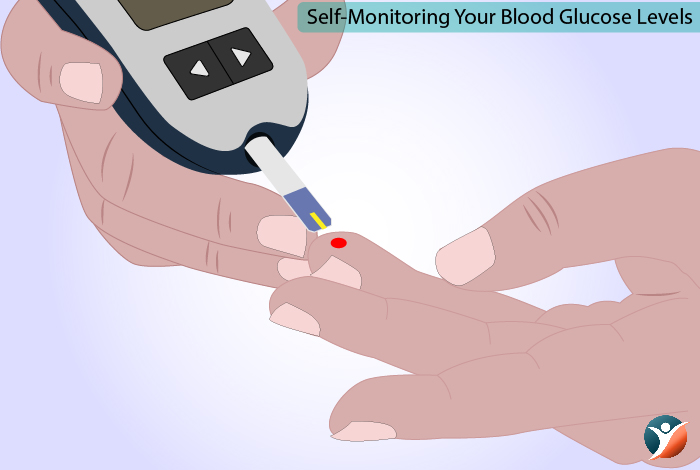
Managing your diabetes is, undoubtedly, a herculean task but with persistent efforts, it gets easier each passing day. One important part of this is to keep a check on your blood glucose levels, generally, few times a day. Self-monitoring is when you check your current blood glucose levels with a blood glucose meter. This also helps you in knowing what were the effects of food or activity, that you indulged in one to two hours ago. Checking your blood sugar level is important to prevent any sudden highs or lows in your blood glucose levels. While important thing is, to have short-term or daily control over your blood sugar levels for achieving a long-term control.
How Can Self-Monitoring Blood Glucose Levels Help You?
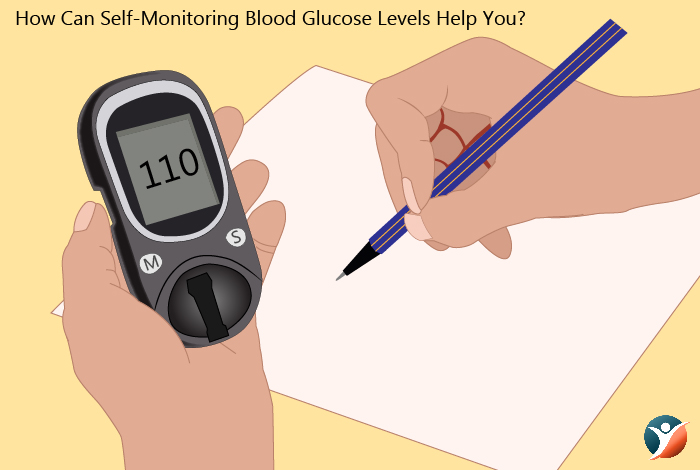
Your doctor will help you out in setting targets or goals for your blood sugar levels. These are normal ranges where your blood sugar must fall, most of the times. Keeping your blood sugar in these ranges would help in slowing down or preventing health complications due to diabetes. Unfortunately, diabetes is a life-long condition, but it can be efficiently managed by being active, eating right and taking medications, if required.
Self-monitoring of blood glucose levels provides all the useful information for managing your diabetes. It can significantly help you in:
- Understanding how well you have been adhering to your overall treatment plan
- Knowing how diet and exercise regimen is affecting your blood sugar levels
- Learning how other factors like illness or stress are affecting your blood sugar levels
- Monitoring effects of diabetes medications on your blood sugar levels
- Identifying whether your blood sugar levels are high or low
- Knowing if your blood sugar levels are in the normal ranges, most of the times
- Knowing whether your activities, food and insulin are matched
- Knowing if you need an extra dose of insulin
- Realizing whether you need to visit your doctor for certain modifications in diet, exercise regimen, medications or not.
Simply put, self-monitoring your blood glucose levels helps you to know if you are staying well within your target blood glucose ranges. If you are outside your targets, you really need to take action right away. However, in cases of persistent out-of-target results, you must visit your doctor for deciding your further plan of action.
Who Must Check Their Blood Glucose Levels?
While diabetics are generally advised to check the blood glucose levels regularly, others might also check their blood glucose levels when doctor asks them. People who may be benefited by checking their blood glucose include the ones who are:
- Taking insulin
- Pregnant
- Having difficulty in controlling their blood glucose levels
- Having persistent low blood glucose levels
- Having low blood glucose levels, but don’t experience any usual warning signs
- Having more ketones due to high blood glucose levels
We advise you to consult your doctor before you start checking your blood glucose levels, all by yourself.
When Should You Check Your Blood Glucose Levels?
Normally, you and your doctor will decide frequency of checking blood glucose levels and timings. This would majorly depend on your treatment plan and also how often you are actually willing to check your blood glucose levels.
Fortunately, people who can effectively manage their diabetes with exercising and eating healthy don’t necessarily need to check their blood glucose daily. They can get away by testing it only once or twice a week. Whereas, people who are on insulin might need to test their blood glucose levels around four times each day.
You might need to check your blood sugar levels, a bit more often if you are sick or under constant stress. This will in-turn help your doctor to review your treatment plan or exercise regimen. Good news is, you can reduce frequency of checking your blood sugar levels if you reach your target blood sugar levels.
A common blood-glucose monitoring plan includes testing:
- Before taking insulin or oral diabetes medications
- Before taking meals
- Before sleeping
- At 3:00 A.M, if you frequently experience low blood sugar reactions during night.
The chart below will give an insight into how many checks diabetics need under different circumstances.
| Type of Diabetes | Treatment Plan | Number of Checks Required Each Day |
| Type-1 | 2-3 insulin injections | 3 checks or more |
| 4 insulin injections or pump therapy | 4 to 8 times | |
| During an illness | Every 4 to 6 hours | |
| Changing routine or treatment | 4 or more times | |
| Type-2 | 2-3 insulin injections | 2 to 3 times |
| 4 insulin injections or pump therapy | 4 to 8 times | |
| Exercise and healthy eating | As advised by your doctor or diabetes educator | |
| Changing routine or treatment | 3 or more |
How to Check Your Blood Glucose Levels?
Checking blood glucose levels is quite an easy task. A lancet, lancing device, a meter and a test strip make the process even simpler and more of a “do it yourself” sort. Your doctor or diabetes educator will tell you how to efficiently check your blood sugar levels, with the blood glucose meter you have bought. You must check the meter label to see if you need to code it with the strips. Not all meters require coding, though. Below are general instructions you need to follow, to measure your blood glucose levels.
1. Prepare your blood glucose testing kit. This includes a test strip, meter, new lancet, lancing device, monitoring dairy and a cotton swab. Also, keep little amount of alcohol for thorough cleaning of your finger or any other site.
2. Wash your hands or clean your finger or its side using alcohol. Make sure your finger is dried, before you prick it for blood. You can also warm up your hands a little in order to obtain a fuller drop of blood when you prick your finger. Make sure to not overheat your fingers, as you might hurt yourself.
3. Prick the site with your lancing device.
4. Put a little blood drop over a test strip.
5. Follow the instructions on your glucose meter packaging, to insert the test strip correctly.
6. Within seconds, your blood glucose meter will read your current blood. glucose level.
7. If the test was unsuccessful, repeat the test again by pricking all over again.
8. If the test was successful, wipe out excess blood with cotton swab.
9. Note the sugar levels in your monitoring diary along with other crucial details including time, date, what you are feeling, your physical activity that day, amount of food you have had and any other special comment.
10. Dispose off the test strip and throw away lancet in the sharps bin.
Here are few tips for proper use:
Read the Instructions Carefully: Test stripes and glucose meters come with instructions for proper use. You must read the instructions carefully to ensure you are using it correctly.
Use the Test Stripes That Suit Your Glucose Meter Best: It is important to use test stripes that are best suited for your glucose meter. Otherwise, you meter might provide inaccurate results.
Know What Might Affect Your Meter’s Accuracy: Certain factors might seriously affect your glucose meter’s accuracy. These include amount of the red blood cells in your blood, other substances if present in blood like glutathione, vitamin C and uric acid. Temperature, humidity and altitude of the place also matters. The quality of your meter and test strips also affect the accuracy of results.
Perform Regular Quality Control Checks: Perform a quality control check every time you begin a new bottle of test stripes or whenever you feel your meter is not giving accurate results. This is an important step, don’t skip doing quality checks.
Let Your Doctor Watch as You Test Yourself: This might sound absurd, but your doctor can tell you whether you are doing it right or not.
Clean Your Meter and Know When to Clean It: Few glucose meters do not require regular cleaning, while others do. Few glucose meters also give notifications, when you need to clean your meter. Follow the instructions on your meter’s manual for cleaning it.
Understand What Your Meter Displays Indicate: You should know various notifications and their means so as to decipher what the meter readings are indicating. Certain times, you meter might also show “Hi” or “Lo” notifications to indicate that the reading is beyond the range that meter can measure.
Make sure to follow all these steps for accurate results and a painless experience. However, always do follow what your doctor or diabetes educator advise.
Other Ways to Check Blood Glucose:
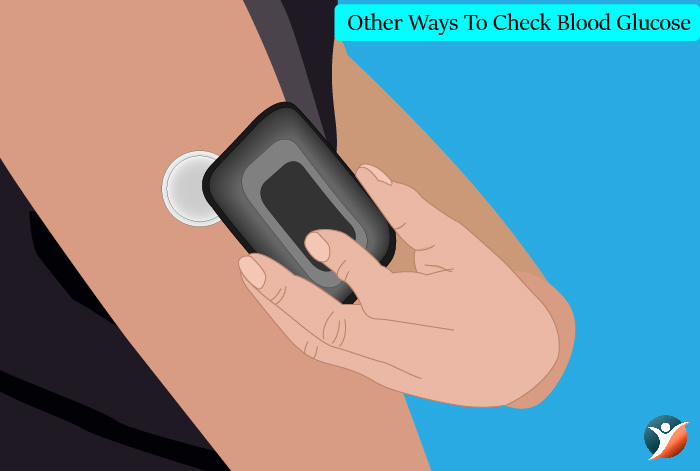
While blood-glucose testing with a glucose meter is a conventional method, CGM or continuous glucose monitoring can also be used to have a track of blood glucose almost 24 hours. A blood glucose meter can help you in checking your current blood glucose whereas a Continuous Glucose Monitoring (CGM) is a minimally invasive method to monitor your blood glucose continuously.
Continuous glucose monitoring is not literally blood glucose monitoring as its sensors are placed into your body and not exactly into your bloodstream. These sensors effectively measure the glucose levels in your interstitial fluid which is the fluid in and around your body cells.
Researchers are much interested in the relationship between glucose levels in the interstitial fluid and blood, as a diabetic can have as many as 288 glucose level readings each day without actually having to prick his or her fingers.
HbA1C levels Test:
The HbA1C blood test is usually conducted at laboratory or at your doctor’s office within every three to six months. This test measures the average amount of blood glucose that was generally there in your blood over last three months. Both daily blood glucose self–monitoring and periodic HbA1C monitoring are essential to keep track of the blood glucose levels. The HbA1C testing can be now done at the ease of your home. This effective yet simple test can actually help you to judge your progress between your periodic visits to the doctor. Though, your doctor will let you know your normal HbA1c value according to your age or any other health condition you have.
Let’s see what does different HbA1c values indicate:
| HbA1c (%) (mmol/L) | What It Signifies |
| 4.5-6.4 | Excellent Level |
| 6.5-7.0 | Good Level |
| 7.1-8.0 | Acceptable Level (in certain cases) |
| > 8.0 | Poor Level |
If your HbA1c levels are not under the targeted levels, you need a change in the strategy to better manage your diabetes.
Estimated Average Glucose or eAG: This number uses the same values and units as results of blood glucose indicate, when you test it using a meter or otherwise after a laboratory test. This estimated average glucose is another way to look at your blood glucose levels over a three months period.
Sites from Where You Can Test Your Blood Glucose Levels:
Few glucose meters allow you to take blood from certain alternative sites as well including base of thumb, forearm, upper arm and thigh. You should know that the blood glucose from these sites would be different than the results received from your finger. Our body uses the blood glucose at different rates from different regions, so you can have two different blood glucose levels at the same time. This is generally a scenario after you take an insulin dose, have a meal or exercise.
You should check blood from your fingertips or side in the following cases:
- If you have had your meal, insulin dose or indulged in physical activity less than 2 hours ago.
- If you have a condition known as Hypoglycemia unawareness. Here you don’t have any signs or symptoms of low blood sugar unless it is indeed very low.
- If the blood glucose results from the alternative site are not in accordance with the way you are feeling.
Simply put, you can use blood from alternative sites only before you consume your meal or two hours after you have had your meal.
How to Select Best Glucose Meter?
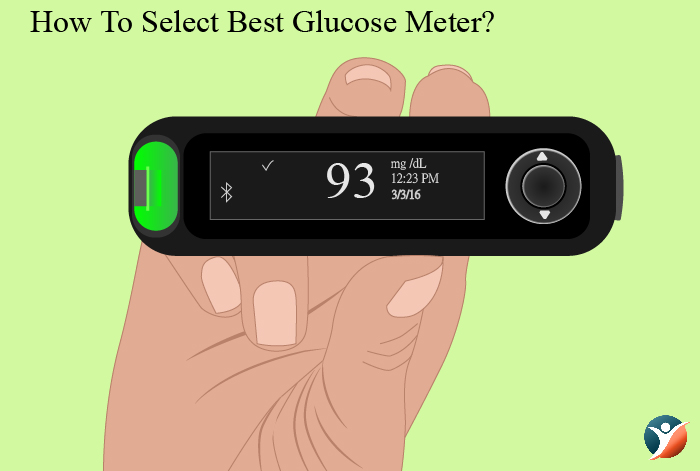
While there are many types of glucose meters to choose from, you must take care of the below-mentioned points before you buy one for yourself.
- Accuracy
- Amount of blood required for each test
- Ease of use
- Pain associated with its use
- Testing speed
- Size of the device
- Memory of the device
- Likelihood of possible interferences
- Its ability to transmit data to a laptop or computer
- Cost
- Ability to check blood glucose from alternate sites
- Good display
- Cost of test strips used
- Doctor’s recommendation
- The technical support provided by the manufacturer
- Special features like large display screen, automatic timing, error codes, spoken instructions or results
Talk to your doctor or health care provider about which glucose meter to use and the correct way to use it.
What Are Recommended Blood Glucose Levels?
Your diabetes educator or your doctor will figure out the best suitable range for you. The table given below provides the ranges recommended by the American Diabetes Association. This helps in knowing when you must take necessary action to get your blood glucose levels back on track.
| Target Range | Normal Range | When To Take Action | |
| Before meal (pre prandial) | 70 to 130 mg/dL | Less than 100 mg/dL | If the result is less than 70 mg/dL or greater than 130 mg/dL |
| 2 hours after meal (post prandial | Less than 180 mg/dL | Less than 130 mg/dL | If the result is less than 70 mg/dL or greater than 200 mg/dL |
| HbA1c levels | Less than 7 mmol/L | Less than 6 mmol/L | If greater than 7 mmol/L |
We encourage you to keep your blood glucose levels in check and make it a point to keep a close watch on your blood glucose.
Generally Recommended Timings of Checking Blood Glucose Levels:
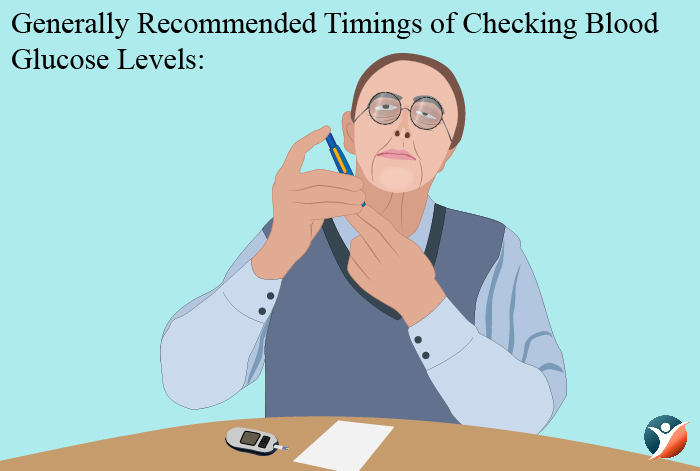
Usually, your doctor or daibetes educator would tell you when you should check your blood glucose levels, but let’s discuss the commonly recommended timings when might be asked to test your blood glucose.
After Fasting:
When you wake up after an overnight fast of 8 to 12 hours and especially before you eat or drink anything, you can check your blood glucose. This test would determine what is really going on with your blood sugar levels at night.
Before Meals:
Check your blood glucose levels at-least 30 minutes before you have your meal. It gives you knowledge about your baseline sugar levels before you have your meal. It would be best if you perform this test when you had your last meal or snacks around 4 hours earlier.
2 Hours After Your Meals:
Checking your blood glucose levels two hours after you have completed your meals gives an estimate of how your blood glucose is affected on consumption of various food items.
Bedtime:
Check your blood glucose around 3 hours after your dinner with no snacks between meals. This test would help in detecting any bedtime hypoglycemia and preventing any night time (nocturnal) hypoglycemia.
2 to 4 A.M.:
If you have symptoms of hypoglycemia during night, you might need to check your blood glucose levels at this time. This would help in checking night-time hypoglycemia and eventually preventing it.
You might need to check your blood glucose levels lesser or more times depending upon your diabetes type, treatment plan and your current health status.
Troubleshoot Common Blood Glucose Monitoring Issues:
It is common to expect few issues while you are checking your blood glucose levels with your glucose meter. Let’s learn what you can do to troubleshoot all these issues, all by yourself.
1. Can’t Get Blood from Your Finger Upon Pricking?
- Place your hands under warn water and rub them gently.
- Hang your hands blow your waist for a little while.
- Grasp your finger just around the area where you want to prick.
- Squeeze the area for around three seconds.
- Keep your hand on a table to avoid moving while you prick it.
- If your lancing device is having a “dial-a-depth”, increase its setting by one level.
- Use a new lancet whenever you are checking your blood glucose.
2. Does It Hurt Too Much When You Prick?
- Decrease your lancing device’s “dial-a-depth” by one level.
- Use a new lancet whenever you are testing your blood glucose levels.
- Try a thinner lancet.
- Use a new lancing device.
- Use sides of your finger instead of fingertips.
- Try alternative sites for checking blood glucose.
- Take advice from your doctor or diabetes educator.
3. Meter Showing Error Message?
- Review the meter’s user manual.
- Ensure that you have used correct amount of blood for testing.
- Ensure that you have placed blood over correct part of the test strip.
- Call your meter’s manufacturer for any other issues with the device.
Your doctor and diabetes educator might be able to help you out further with additional tips.
Times When You Should Check Your Blood Glucose More Often:
There will be days when you might need to check your blood glucose more often. However, you must first discuss this concern with your diabetes educator or doctor. Below are few examples when you will be asked to check your blood glucose levels more frequently.
- Being very less physically active or extremely physically active
- If you are either ill or stressed
- Experiencing drastic changes in your daily routine or eating habits like traveling
- Adjusting or changing your insulin dose or medication
- Experiencing signs and symptoms of low blood sugar or hypoglycemia
- Experiencing signs and symptoms of high blood sugar or hyperglycemia
- Frequently experiencing morning headaches or night sweats
- If you are planning pregnancy or are pregnant
- Before and after minor surgical procedures
- After any dental procedures
Your diabetes educator or doctor can help you in figuring out a relevant testing plan that suits you.
Why Is Your Blood Glucose Average Crucial?
Reviews of your blood glucose data by your doctor or diabetes educator is an important aspect of diabetes management. You must also record date, time, medication, insulin dose, whether you ate more or less on that particular day, physical activity and any other special comment along with your blood glucose levels.
This would help you in understanding the patterns and you would know how physical activity, medications, insulin dose, food, stress and various other events in your life affect your blood glucose levels.
Upon close examination of the data, either you or your doctor might be able to tell the cause behind your off-limits blood glucose levels. You should make all the necessary changes in your life and medications to keep your blood glucose levels in check.
What Are the Risks Associated with Blood-Glucose Monitoring?
The risks of blood glucose monitoring are rather minimal as compared to not testing your blood sugar levels altogether, if you are a diabetic. If you share your testing supplies and insulin needles with someone else, you are at an increased risk of both developing and spreading certain serious health conditions including
- HIV/ AIDS
- Hepatitis B
- Hepatitis C
You must never share finger-stick devices and needles for any reason whatsoever.[1]
Latest Advances in Blood Glucose Monitoring:
With millions of diabetics all around the world, it is not new that umpteen number of painless and minimally invasive devices are being manufactured and their makers are striving to garner limelight.
The U.S. Food and Drug Administration (FDA) has recently approved a continuous blood sugar monitor that doesn’t require any backup finger pricks.
Current blood glucose testing models require users to test their blood twice daily for efficiently calibrating and adjusting the meter. The cost of supplies and pain discourage most people from keeping regular track of their blood sugar. As a result, they don’t have much knowledge of how to adjust their lifestyle and medications for improved blood glucose levels.
Abbott’s FreeStyle Libre Flash Glucose Monitoring System, was approved recently by FDA and uses a small sensor that is attached to upper arm. Patients can easily wave a reader device over the sensor to check their current blood sugar level and how much it has changed over past 8 hours.
Most of the diabetics use standard glucose meters and the process requires multiple finger pricks each day. Unfortunately, it shows only the current glucose levels. Much accurate CGM or continuous glucose monitoring devices are also used by a little chunk of diabetic population in the U.S. We hope soon there will be plethora of painless and accurate devices to keep a close watch on your blood glucose.
Conclusion:
Effective diabetes management requires a careful balance between foods you consume, how physically active you are and the oral medications you take for managing your condition. It might have been quite difficult to achieve this intricate balance if several easy and accurate glucose monitoring methods wouldn’t have been there.
The blood glucose ranges vary from individual to individual. While we have already provided the normal ranges for your blood glucose levels, but it is also necessary to consult your doctor or diabetes educator for knowing the best possible range that suits you best. We advise you to consider the information in this article as general information.
Did you enjoy reading the article? Have you followed any of our recommendations to improve your blood sugar levels. We look forward to hearing from you. If you have any suggestion or advice, feel free to post your comment below. We promise to share more ways and means for monitoring your blood glucose every day. For latest information, keep checking this space out.





